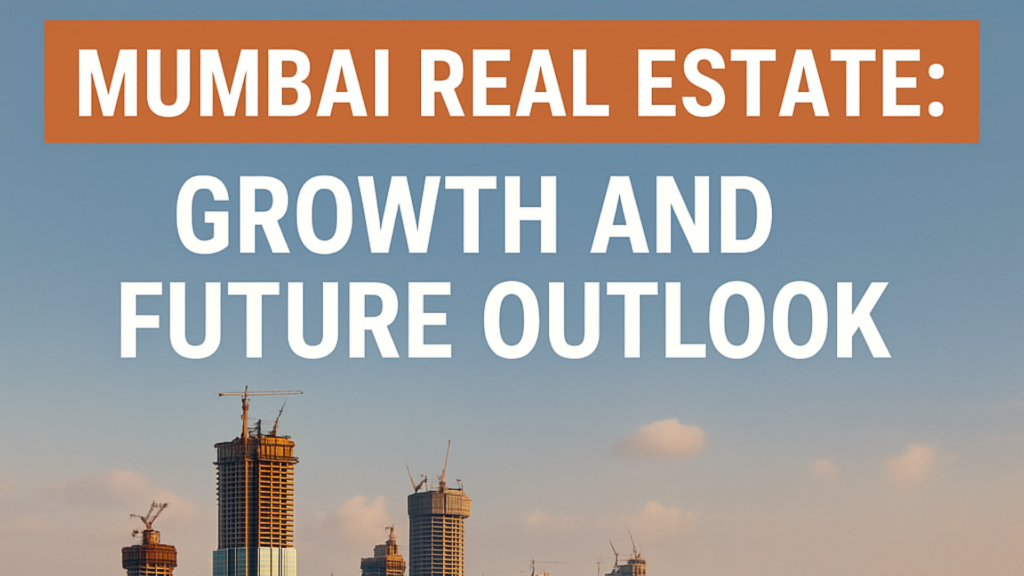

Mumbai Real Estate 2025; Investment, Growth & Future Out look
In recent years, Mumbai’s real estate market has become a symbol of dynamic urban growth, infrastructure transformation, and shifting demographic trends. Known as the financial capital of India, Mumbai has always been a magnet for investment, aspiration, and development. Yet, in 2025, the city’s real estate landscape reflects more than just concrete and skyscrapers — it encapsulates India’s evolving socio-economic fabric, the growing demand for sustainability, and the pursuit of integrated urban living.
This essay explores the recent growth in Mumbai’s property sector, highlights key market trends, and presents a thoughtful forecast for the future, offering valuable insights for investors, homebuyers, and developers alike.
Also Read; Why Financial Services Are the Best Investment for 2025
The Growth Trajectory of Mumbai’s Real Estate Market
Mumbai’s real estate market in 2025 has shown consistent and resilient growth, despite global economic slowdowns and interest rate fluctuations in previous years. One of the primary factors fueling this growth is infrastructure expansion. With the completion of several major projects — including the Mumbai Coastal Road, the Mumbai Metro Line extensions, the Trans-Harbour Link, and the upcoming Navi Mumbai International Airport — property demand has seen a marked increase across both central and peripheral zones.
Another major driver of growth is the surge in urban migration and the rise of the aspirational middle class. The increasing population of working professionals, especially in sectors like finance, IT, media, and start-ups, has led to heightened demand for residential units across suburban micro-markets such as Thane, Panvel, and Chembur. These areas, once considered fringe zones, have transformed into investment hotspots due to better connectivity and affordable housing.
Current Market Trends Shaping the Landscape; Mumbai Real Estate 2025
The Mumbai property market is no longer just about location; it is increasingly about lifestyle, sustainability, and technology. Several noteworthy trends are currently shaping the market.
Firstly, green buildings and smart homes are gaining popularity. Modern homebuyers are more conscious of environmental impact and energy efficiency. As a result, new residential projects now include solar panels, rainwater harvesting systems, smart lighting, and digital security solutions. Real estate developers are incorporating green building certifications such as IGBC and LEED to attract a new generation of environmentally conscious consumers.
Secondly, there has been a significant rise in co-living spaces and flexible work accommodations. The post-pandemic shift towards hybrid working models has increased the demand for housing options that offer high-speed internet, workstations, and communal facilities. Co-living accommodations, especially in areas like Powai, Lower Parel, and Vikhroli, have become popular among millennials and young professionals due to their affordability and convenience.
Thirdly, mixed-use developments and transit-oriented housing are gaining momentum. Real estate developers are focusing on integrating commercial, retail, and residential spaces within walkable distances of metro stations and arterial roads. This offers residents a more holistic lifestyle and reduces commuting stress, aligning with global urban planning trends.
Emerging Micro-Markets and Investment Zones
With saturation and high pricing in core city areas like South Mumbai and Bandra, investors are looking at emerging micro-markets that offer better returns. Thane, for instance, has evolved into a residential and commercial hub due to its excellent infrastructure, malls, schools, and increasing corporate presence. Panvel and Ulwe are witnessing rapid appreciation owing to proximity to the Navi Mumbai Airport and the Trans-Harbour Link. Other promising areas include Dahisar, Kanjurmarg, and Taloja, all of which are benefiting from metro connectivity and new township developments.
These zones are particularly attractive for first-time buyers and long-term investors due to a lower entry price point and projected capital gains in the coming decade.
Challenges on the Horizon; Mumbai Real Estate 2025
Despite the overall optimism, Mumbai’s real estate sector also faces a number of challenges. Affordability remains a critical issue, especially in central zones where property prices are beyond the reach of the average salaried buyer. This has led to a demand-supply mismatch in the luxury segment, with unsold inventory piling up in certain high-end projects.
Moreover, the city continues to grapple with issues related to land scarcity, outdated regulations, and environmental concerns like flooding and poor air quality. These factors could dampen investor confidence if not addressed through comprehensive urban policies and stricter compliance norms.
Future Outlook: 2025 and Beyond;Mumbai Real Estate 2025
Looking ahead, Mumbai’s real estate future is poised for both expansion and transformation. Policy reforms, such as the digitization of property records, simplified tax structures, and the push for green infrastructure, are likely to enhance transparency and buyer confidence.
By 2030, experts predict that Mumbai will evolve into a multi-nodal metropolis where connectivity, sustainability, and lifestyle integration become the new standards. The shift towards smart cities, supported by technologies like blockchain for land registration and AI for predictive property analytics, will redefine how real estate transactions are conducted.
As housing preferences shift from ownership to access, and from size to functionality, developers who adapt to these changes will remain ahead of the curve.
Also Read; शून्य निवेश; बिजनेस आइडिया और निष्पादन रणनीति रणनीति
Conclusion; Mumbai Real Estate 2025
Mumbai’s real estate market in 2025 stands at a pivotal crossroads — rich with opportunity, yet not without its hurdles. While rising prices, growing infrastructure, and digitization continue to push the boundaries of what’s possible, challenges in affordability and inventory management cannot be overlooked. For investors, homebuyers, and developers, the key lies in recognizing long-term trends, aligning with government policy, and embracing innovation. From luxury skyscrapers in Worli to green townships in Panvel, the city continues to be a living, breathing example of India’s real estate ambition. As the next decade unfolds, Mumbai will not just expand; it will reinvent how urban India lives, works, and invests



